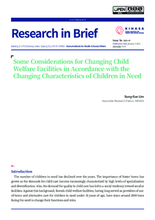Introduction
The number of children in need has declined over the years. The importance of foster home has grown as the demands for child care become increasingly characterized by high levels of specialization and diversification. Also, the demand for quality in child care has led to a social tendency toward smaller facilities. Against this background, Korea’s child welfare facilities, having long served as providers of out-of-home and alternative care for children in need under 18 years of age, have since around 2000 been facing the need to change their functions and roles. Child care facilities divide in a broad sense into two types: residential and nonresidential. Residential facilities, which provide out-of-home care, are of two types: general residential facilities and treatment/ training facilities. General residential facilities include foster care facilities and group home. Treatment and training facilities are aimed at providing temporary protection, therapeutic treatment and independent-living support. This brief discusses ways in which the roles and functions of Korea’s child welfare facilities should change to better meet the diverse needs of children in need.

